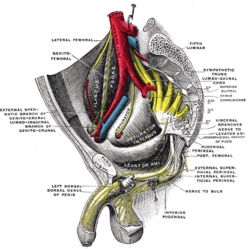Presacral space
In human anatomy, the presacral space is inside the pelvis, behind the rectum and in front of the coccyx and sacrum. Normally it is empty, or it contains a pocket of fat.
| Presacral space | |
|---|---|
 Sacral plexus of the right side. (Presacral space visible but not labeled.) | |
| Anatomical terminology |
It is usually covered by sigmoid colon.[1]
Clinical significance
The presacral space may contain one of several kinds of tumor. The most common tumor here is sacrococcygeal teratoma. Others are retrorectal hamartoma (tailgut cyst), schwannoma, ganglioneuroma, and ependymoma. Also sometimes found here is an anterior meningocele, a relatively mild form of neural tube defect.
Causes of increased pre-sacral space are: ulcerative colitis, granulomatous colitis, lymphogranuloma venereum, and in postirradiation changes, thrombosis of the inferior vena cava and tuberculous proctitis, tumor of the sacrum or posterior wall of the rectum. Carcinomatous deposits in the pelvis can also cause presacral space widening.
Presacral edema is common in patients with heart failure who are confined to bed.[2]
References
- Linda Cardozo; David Staskin (2006). Textbook of female urology and urogynecology. CRC Press. pp. 1195–. ISBN 978-1-84184-358-2. Retrieved 19 May 2011.
- Braunwald, Eugene; Loscalzo, Joseph (2015). "Edema". In Kasper, Dennis L.; Fauci, Anthony S.; Hauser, Stephen L.; Longo, Dan L.; Jameson, J. Larry (eds.). Harrison's Principles of Internal Medicine (19th ed.). New York: McGraw Hill Education. pp. 250–253. ISBN 978-0-07-180213-0.
Additional images
- Presacral space.Deep dissection. Anterior view.
External links
- pelvis at The Anatomy Lesson by Wesley Norman (Georgetown University) (malepelvissagittalmidlinestruct)